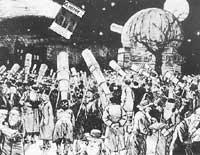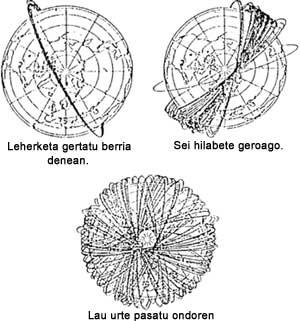First garbage... and space advertising (and II)
1993/10/01 Arregi Bengoa, Jesus Iturria: Elhuyar aldizkaria
Despite the fact that the problems caused by satellites in orbit and their residues are important (especially for space navigation), astronomers have closer the main reasons to worry. Of course, we talk about electromagnetic contamination.
Although the telescopes are located in high and isolated places, the luminosity of the large cities is evident. To partially solve the problem and after many requests, it has been possible that sodium lamps are used in cities close to some observatories. When making the observations it is very easy to filter the monochromatic light produced by sodium and are also lamps of very good economic performance.
In the field of radio waves the problems are not minor, for example, the use of an automatic opening system of the garage door can be enough for, despite being a few kilometers away, problems arise in the computers that provide the images of the radio telescope. The radio waves, unlike the visible light, can easily cross the atmosphere. Therefore, to locate the radiotelescopes, not much height is required, as in the case of optical telescopes. On the contrary, they are usually installed in the valleys, taking advantage of the protective work carried out by the mountains, making it difficult to propagate the radio waves. However, mountains cannot avoid the interferences caused by communications with planes and satellites. On the other hand, satellite telephone networks or high-definition television systems are a source of inexhaustible problems.

With the previous ones the problems are not over. Radio astronomers have exclusive frequencies to be able to collect and analyze the weak signals that arrive from the wide space. These frequencies are also strongly attacked by the presence of illegal or excessive signals in nearby frequencies.
All these problems would be nothing Space Marketing Ind. If projects like the one that the company wants to carry out are spread. The aforementioned association announced last April its intention to put in orbit a bulletin board of one kilometer and a half in length. The unemployment generated by the budget constraint to the “war of the stars” and other programs related to space research among space technicians has led to new companies of commercial exploitation of space. This project is the result of one of his first projects. We will analyze the main details of this project.
The idea would be to put in orbit a structure similar to the inflatable balloon at the base. Logically, the launch would be wrapped, and once the proper orbit reached, about 300 km high, it would swell until reaching the aforementioned measure. The message written in the table under these conditions could be read at a glance.
Like the Moon, the bulletin board would look like to reflect the light of the Sun, but not all night. It would be seen at dawn and at dusk, during a quarter of an hour in each view. At night the orbit would pass through the shadow of the Earth. Therefore, the table would be eclipsed. Due to the dimensions of the object and its low orbit, the announcement would only be seen from some regions of the Earth, but this limitation could also have a solution, since a change of orbit can be made during the flight. At first the announcement would turn in orbit about 30 days, then fall into the atmosphere and be destroyed.
As is to be expected, the only reason why the project has not yet been implemented is economic. The amount that the advertiser should pay ranges between 20 and 30 million dollars. Undoubtedly, it is a great quantity, but at all impossible for some multinationals. If we take into account the fame and prestige of such an initiative, it would not be strange that several of these companies considered the operation profitable.
The project can be carried out. Hence the intense protests of astronomers. The biggest concern, moreover, would not be this same project, but those who could then come. The objectives would be opened soon, increasing the orbits, the deadline and the dimensions of the ads. Kneading would become too clear to perform observations provided by astronomers. Astronomers have already begun to wonder if it is interesting to try to improve the resolution of instrumentation on telescopes or radiotelescopes (in order to receive increasingly weak signals), if the telescope should then be saturated by light or by parasitic waves.
On this occasion, astronomers are not alone. Some senators have also opposed the bill and are trying to pass a law that prohibits carrying out that intent.
Anniversaries of October SUN: October 23 at 9h 37min (UT) enters Scorpio.
MERCURY ON THE PLANETS: reaches its eastern peak elongation on October 14. It should be seen in the evening, but it is in very bad conditions and it is very difficult to detect. It appears a couple of hours before the Sun. Therefore, we lose it for a few months. In October it hides almost with the Sun.JUPITER: October 18 is in conjunction, so SATURN: we can see from the evening until two (UT) in the morning. Therefore, we still have a good time to see it. |

Gai honi buruzko eduki gehiago
Elhuyarrek garatutako teknologia





